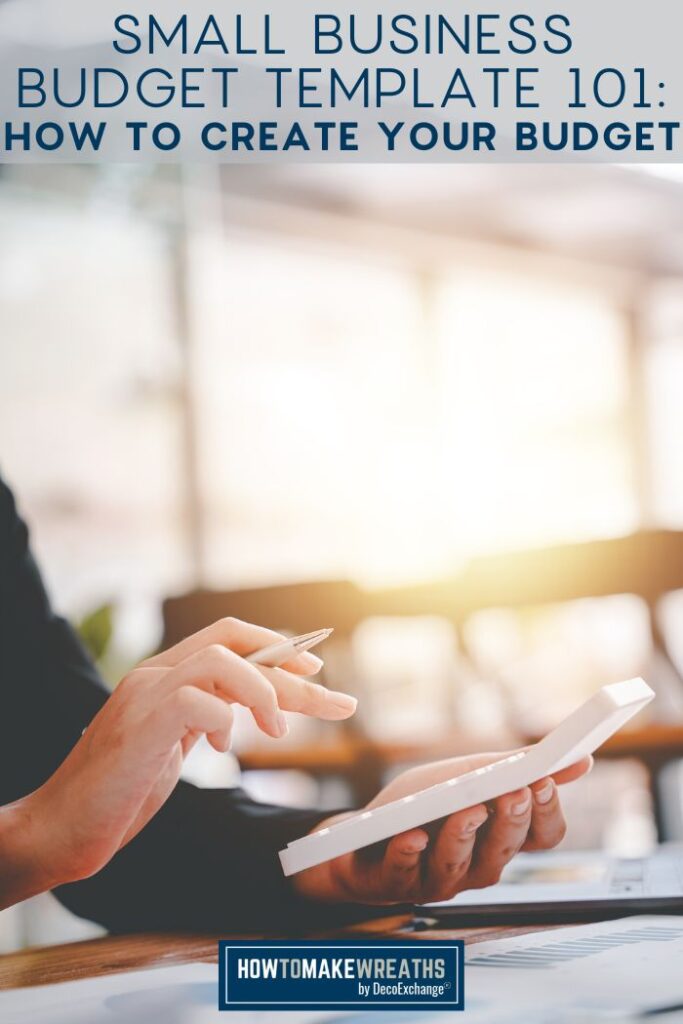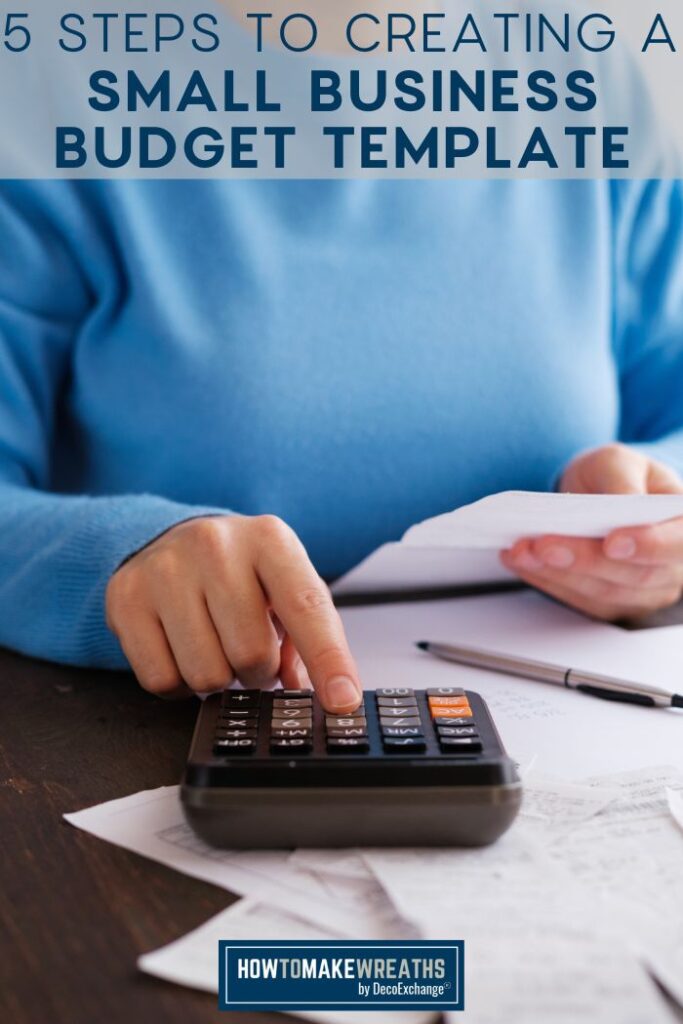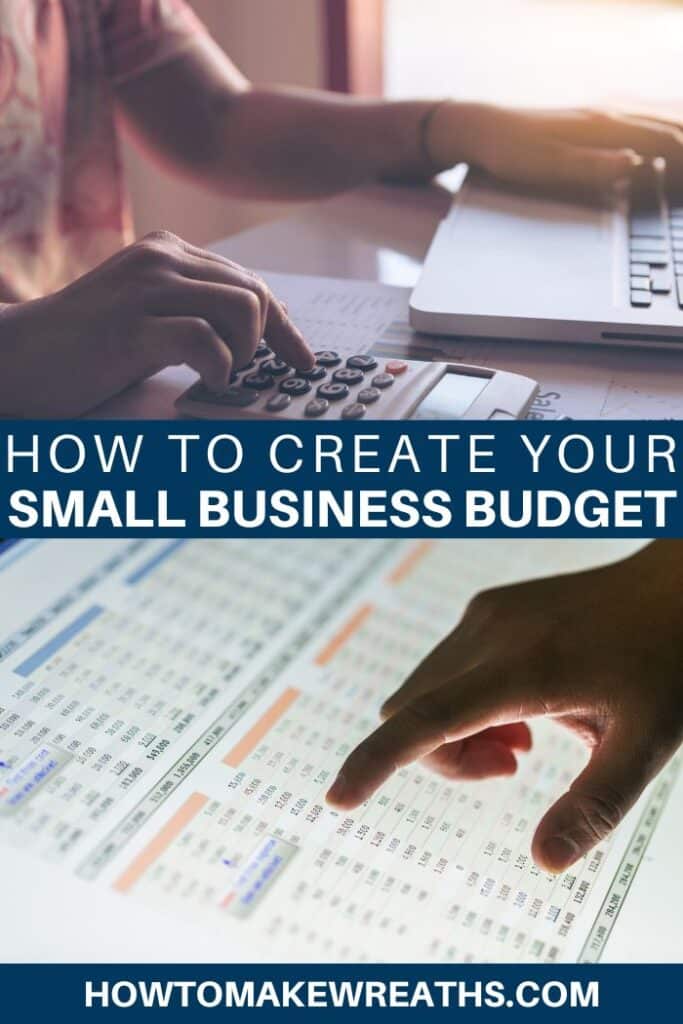Learning how to create a small business budget can be confusing, especially for new Craftpreneurs. In this post, we share with you our own small business budget template to help you get started on yours.
Hey, y’all! Since I receive questions all the time about how to run a successful business, I’ve been creating more and more content to help you learn how to run your own business.
Whether you are trying to figure out how to calculate the cost of your craft supplies, how to price your wreaths for profit, or anything else, I’m here to help.
In fact, I realized just how much I can help others with my knowledge about running a business that I now have a business coaching group. This is the perfect online gathering space for anyone who is serious about also running a growing and profitable business!
Do you know what a major part of running a profitable business is? Yep, it’s a budget.

Use Our Small Business Budget Template To Create Your Own Business Budget
Here’s a little hard truth: If you don’t set a budget in your small business, you won’t allocate your incoming money in the right way (like paying yourself!).
Many small business owners think that creating a budget is too hard and consider this to be the least favorite part of running their own business…especially creative people like us.
I want to help change that for you! If you truly want to be a successful Craftpreneuer, a huge component of that success will be to create and maintain a small business budget.
Why do you need to create a small business budget?
Y’all, here is the straight scoop. Using a budget will help ensure long-term business success. We all want that, right?
A budget is a tool that helps you see past yesterday or last week to objectively evaluate last month and last year to help you also look forward and plan.
From Day 1, we have been using a simple business budget template because we knew that it would help us to:
- Make operating our business easier
- Helps us know how to allocate funds appropriately and efficiently
- Provide a method for predicting slow periods so we can plan and avoid going into debt
- Help us know the exact state (profitability) of our business at any given time
5 Steps To Creating A Small Business Budget Template
If you haven’t started figuring out your business budget yet, it’s definitely time to get working on that!
Here are 5 simple steps to get you well down the path of creating your budget. If you want to watch me walk through the process, you can check out this video.
1. Determine Your Revenue
Start with figuring out how much money you bring in on a monthly basis. You can break that down even further if you need to at first. I would recommend looking at how much money you bring in with each wreath that you sell.
When you’re doing this, make sure to calculate your revenue (not your profit).
Learn more by checking out Wreath Prices: How To Price Homemade Wreaths!
2. Deduct Your Fixed Costs
A fixed cost is ANY expense that recurs on a REGULAR basis and is necessary for operating your business. Fixed costs can occur daily, weekly, monthly, or yearly.
Some examples of fixed costs include:
- Rent
- Memberships
- Ads
- Insurance
Add up all your fixed costs and then subtract that number from your revenue number!
3. Subtract Variable Expenses
As you examine your expenses, you’ll find variable expenses as well. These are usually one-time expenses or expenses that happen for a short time and can be adjusted when needed.
For our purposes, we will call them capital expenses.
4. Figure out Your Slush Funds
Once you know what your incoming revenue is and what all your expenses are, you can determine your budget “buckets”. Consider each of these buckets your “slush funds” – you’ll use these to allocate money to the right places in order to help your business thrive.
We break down our slush funds into these categories:
- Supplies
- Shipping
- Capital
- Payroll
- Expenses
To learn this part in more detail, check out How To Calculate The Cost Of Goods Sold For Crafting.
Use This Template To Create Your Own Business Budget
Because every small business has different revenue and different expenses, I can’t tell you exactly how much to allocate for your expenses. Instead, I am going to show you how to create your own budget by using percentages!
Once you figure out your expenses, you’ll use those numbers (especially the cost of your supplies) to figure out your pricing formula. There are several ways to structure a pricing formula, and you can use any way that works for you.
Here are a couple of real-life small business budget template examples for you to check out. Y’all, this is how I do my own budgeting!
If you want to learn about these more in-depth, watch my video as I walk through each one.
Budget Without Shipping Included
This budget template would be one where your customer pays for shipping when they purchase your wreath.
Price of wreaths = Cost of Supplies x3 (if your supplies cost $33, you would sell your wreath for $99)
For this pricing formula, allocate your revenue according to these percentages:
- 33% = supplies (your shopping budget)
- 17% = capital (slush fund for one-time expenses such as starting a website, education, buying your craft show setup, etc)
- 10% = advertising
- 20% = payroll (this is income for YOU and everyone on your payroll)
- 20% = expenses (recurring costs to run your business)
Budget With Shipping Included
This budget template would be one where you include the cost of shipping in the cost of your wreath.
Price of wreaths = Cost of Supplies x4 (if your supplies cost $33, your wreath would cost $132)
For this pricing formula, allocate your revenue according to these percentages:
- 25% = supplies
- 25% = shipping
- 10% = capital
- 20% = payroll
- 20% = expenses (in this model, expenses include ads)
Note: Whenever you do a flat rate shipping expense as this plan does, sometimes you’ll make money on shipping, and sometimes you’ll lose money. You’re relying on average shipping costs over time to reach that 25% you allocated.
Are You Ready To Do It Yourself?
Y’all, there are other ways to figure out your pricing formula too! You may have to use a different formula based on your industry (or preference).
The bottom line: it doesn’t matter which one you use…just use a pricing formula to help you determine how much to charge for your wreath so you can create an accurate budget for your business.

That’s it. I know at first it sounds confusing and overwhelming, but give it a go. I just know that with a little experience and practice, you won’t have any problem creating (or maintaining) your business budget template!
FAQs
Here are a few questions I see readers ask. If you have a question but don’t see it answered, leave it in the comments! Chances are that if YOU have a question, someone else will have it too and benefit from being able to see the answer.
How do I create a budget for small businesses in Excel?
Good question! I find it helpful to keep track of our budget in an Excel spreadsheet because it will automatically tally all the numbers. All I have to do is set up the spreadsheet and enter our expenses and income in the appropriate places. You can learn more about this in our Business Coaching Group!
What are the characteristics of a successful budget?
In order for your small business budget to work, it needs 4 things. Make sure that it’s:
- Realistic – in order for your budget to be accurate, you need to be honest about how much you’re spending.
- Flexible – things can fluctuate, so you need to be able to make adjustments.
- Well thought out – make sure to include all the buckets I mentioned, or adjust your budget to include other necessary buckets that you need.
- Consistent – sticking to your budget only works if you make the effort to consistently check in with it.
What is the key to a successful business budget?
Consistency is the biggest factor in managing a successful budget. Think of budgeting as a marathon instead of a sprint because it’s a long-term process.
If you can consistently log your expenses, investigate ways to reduce wasteful spending, and check in on your progress toward your goals, your budget will be one of the most important tools for your business success.
What is a common mistake made in budgeting?
The most common mistake I’ve seen with Craftpreneurs is not being accurate about business spending. It might be a simple mistake in estimating, or you might do additional spending that you don’t factor into your budget.
Since underbudgeting your spending will leave you with less money to allocate towards other expenses (like your own paycheck), it’s important to be accurate.
More Business Inspiration
Creating a small business budget template is the key to running a successful business. If you want to start your own wreath business or help scale it to achieve your dreams, check out these other posts:
- The Benefit Of Business Collaborations
- How To Be Authentic In Business
- Business Goals Coaching: STU Method
- Business Laptop Recommendations To Propel Your Business Into The Next Year
- Tips For Building Your Business
If you have any questions about this process, please leave a comment below or post your comment in our How To Make Wreaths Facebook Group.
We’d love to hear your ideas or feedback! If you need more help pricing your wreaths we have a full detailed lesson all about pricing in our Business Coaching Group.
If you are interested in more info on learning how to sell wreaths, how to make wreaths, where to buy supplies, and being in a community of like-minded crafters, check out our Creative Coaching Subscription Group.
Just pin this small business budget template to save it for next time!








